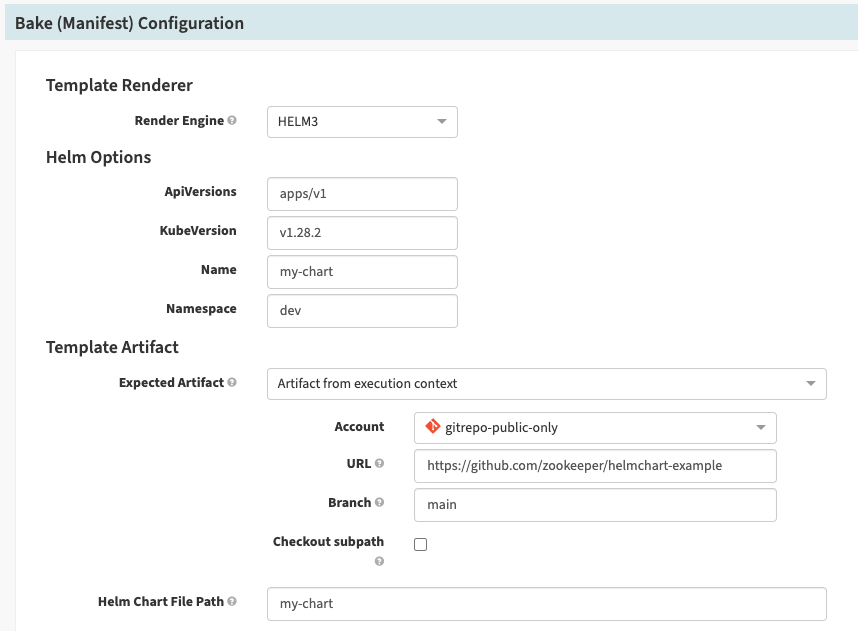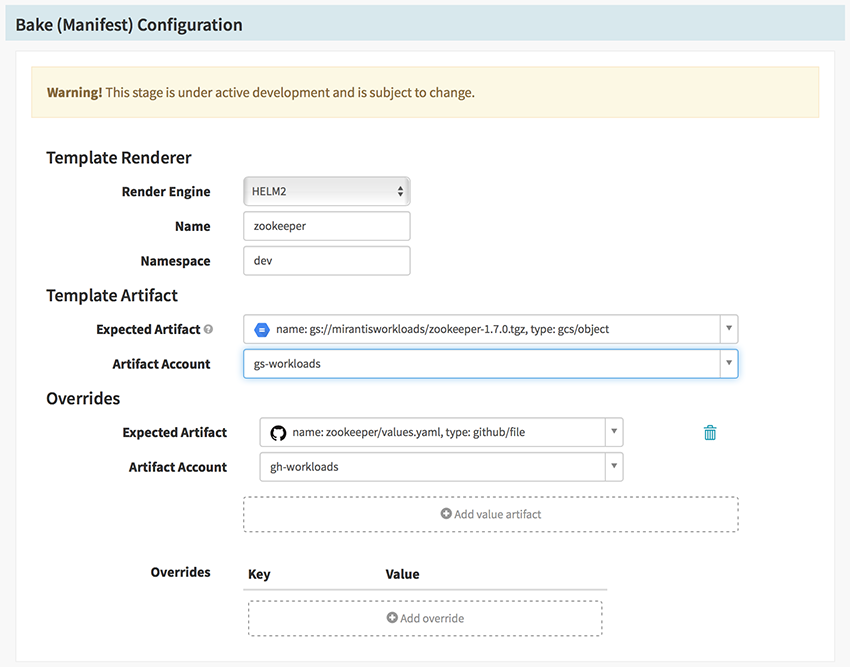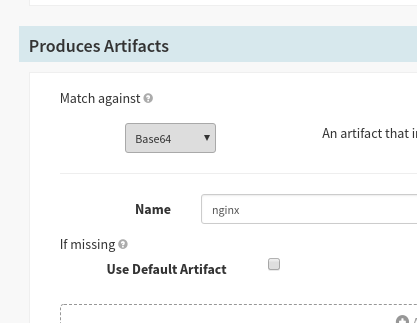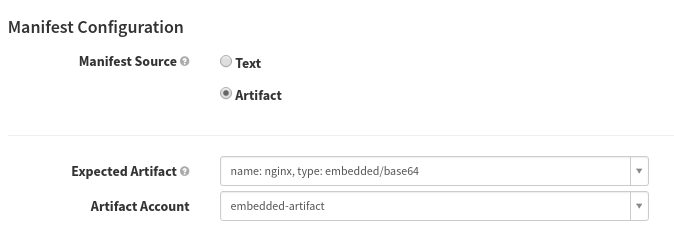Deploy Helm Charts
Spinnaker surfaces a Bake (Manifest) stage to turn templates into manifests
with the help of a templating engine.
Helm
relies on the helm template command.
For more details, see helm template --help.
This stage is intended to help you package and deploy applications that you own, one that are actively developing and redeploying frequently. It is not intended to serve as a one-time installation method for third-party packages. If that is your goal, it’s better to call
helm installonce when bootstrapping your Kubernetes cluster.
Make sure that you have configured artifact support in Spinnaker first. All Helm charts are fetched/stored as artifacts in Spinnaker. Read more in the reference pages.
Configure the Bake (Manifest) stage
When configuring the Bake (Manifest) stage using a Helm (Helm 2 or Helm 3) render engine, you can specify the following:
The release name (required)
The Helm release name for this chart. This determines the name of the artifact produced by this stage.
Note: this name overrides any changes you make to the name in the Produces Artifacts section.
The template artifact (required)
The Helm chart that you deploy, stored remotely as a
.tar.gzarchive. You can produce this by runninghelm package /path/to/chart. For more details,helm package --help.
Configure API versions and a Kubernetes version
To begin, you must set API_VERSIONS_ENABLED to true. This is an essential Deck environment variable that enables the functionality necessary to work with API versions and a Kubernetes version in your CD pipeline.
The capabilities apiVersions (optional)
The
apiVersionsfield in theCapabilitiesobject represents a set of API versions that are dependent on the Kubernetes version. You can pass these API versions as an argument to the--api-versionsparameter in thehelm templatecommand. This enables you to specify which Kubernetes API versions should be used when rendering your Helm templates.The release kubeVersion (optional)
The
kubeVersionfield in theCapabilitiesobject signifies the Kubernetes version itself. You can pass this Kubernetes version as argument to the--kube-versionparameter in thehelm templatecommand. It specifies the exact Kubernetes version you want to use when rendering your Helm templates.Note: Not all Helm charts contain apiVersions and kubeVersion definitions in their manifests. Make sure that your manifests contain the following code:
data: apiVersions: {{ .Capabilities.ApiVersions }} kubeVersion: {{ .Capabilities.KubeVersion }}In this example, you have a fully configured Bake (Manifest) stage, including the ApiVersions and KubeVersion fields:

The release namespace (optional)
The Kubernetes namespace to install release into. If parameter is not specified, Spinnaker uses the default namespace.
Note: Not all Helm charts contain namespace definitions in their manifests. Make sure that your manifests contain the following code:
metadata: namespace: {{ .Release.Namespace }}Helm chart file path (optional)
Helm chart file path is only relevant (and visible) when the template artifact is a git/repo artifact. It specifies the directory path to Chart.yaml in the git repo. If absent, Spinnaker looks for Chart.yaml in the root directory of the git repo.
Given: A git repo where your
Chart.yamlis in:sub/folder/Chart.yml
Then:helmChartFilePath: "sub/folder/"Note: Leading slashes do not work in
helmChartFilePath.Zero or more override artifacts (optional)
The files passed to
--valuesparameter in thehelm templatecommand. Each is a remotely stored artifact representing a Helm Value File .Statically specified overrides
The set of static key/value pairs that are passed as
--setparameters to thehelm templatecommand.
Configuration example
In this example, you have a fully configured Bake (Manifest) stage:

Notice that in the Produces Artifacts section, Spinnaker has automatically created an embedded/base64 artifact that is bound when the stage completes, representing the fully baked manifest set to be deployed downstream.

If you are programatically generating stages, here is the JSON representation of the same stage:
{
"type": "bakeManifest",
"templateRenderer": "HELM2",
"name": "Bake nginx helm template",
"outputName": "nginx",
"inputArtifacts": [
{
"account": "gcs",
"id": "template-id"
},
{
"account": "gcs",
"id": "value-id"
}
],
"overrides": {
"replicas": "3"
},
"expectedArtifacts": [
{
"defaultArtifact": {},
"id": "baked-template",
"matchArtifact": {
"kind": "base64",
"name": "nginx",
"type": "embedded/base64"
},
"useDefaultArtifact": false
}
]
}
Helmfile
In addition to standard Helm deployments, Spinnaker supports Helmfile as a templating engine. You can find the supported version in Rosco’s Dockerfile .
Configuring a Helmfile deployment follows the specification for standard helm chart deployments (defined above) with one exception - helmChartFilePath is substituted for helmfileFilePath and is specified as follows:
helmfile file path (optional)
helmfilefile path is only relevant (and visible) when the template artifact is a git/repo artifact. It specifies the directory path to helmfile.yaml in the git repo. If absent, spinnaker looks for helmfile.yaml in the root directory of the git repo.Given: A git repo where your
helmfile.yamlis in:sub/folder/helmfile.yml
Then:helmfileFilePath: "sub/folder/"Note: Leading slashes do not work in
helmfileFilePath.
Configure a downstream deployment
Now that your manifest set has been baked by Helm, configure a downstream stage (in the same pipeline or in one triggered by this pipeline) your Deploy (Manifest) stage to deploy the artifact produced by the Bake (Manifest) stage:

Note: Make sure to select “embedded-artifact” as the artifact account for your base64 manifest set. This is required to translate the manifest set into the format required by the deploy stage.
When this stage runs, you can see every resource in your Helm chart get deployed at once:

Other Templating Engines
In addition to Helm, Spinnaker also supports Kustomize as a templating engine. For more information, see Using Kustomize for Manifests .